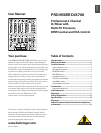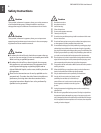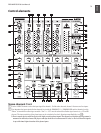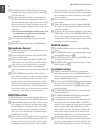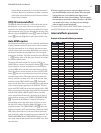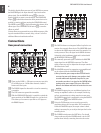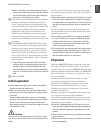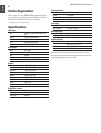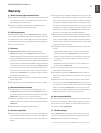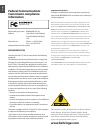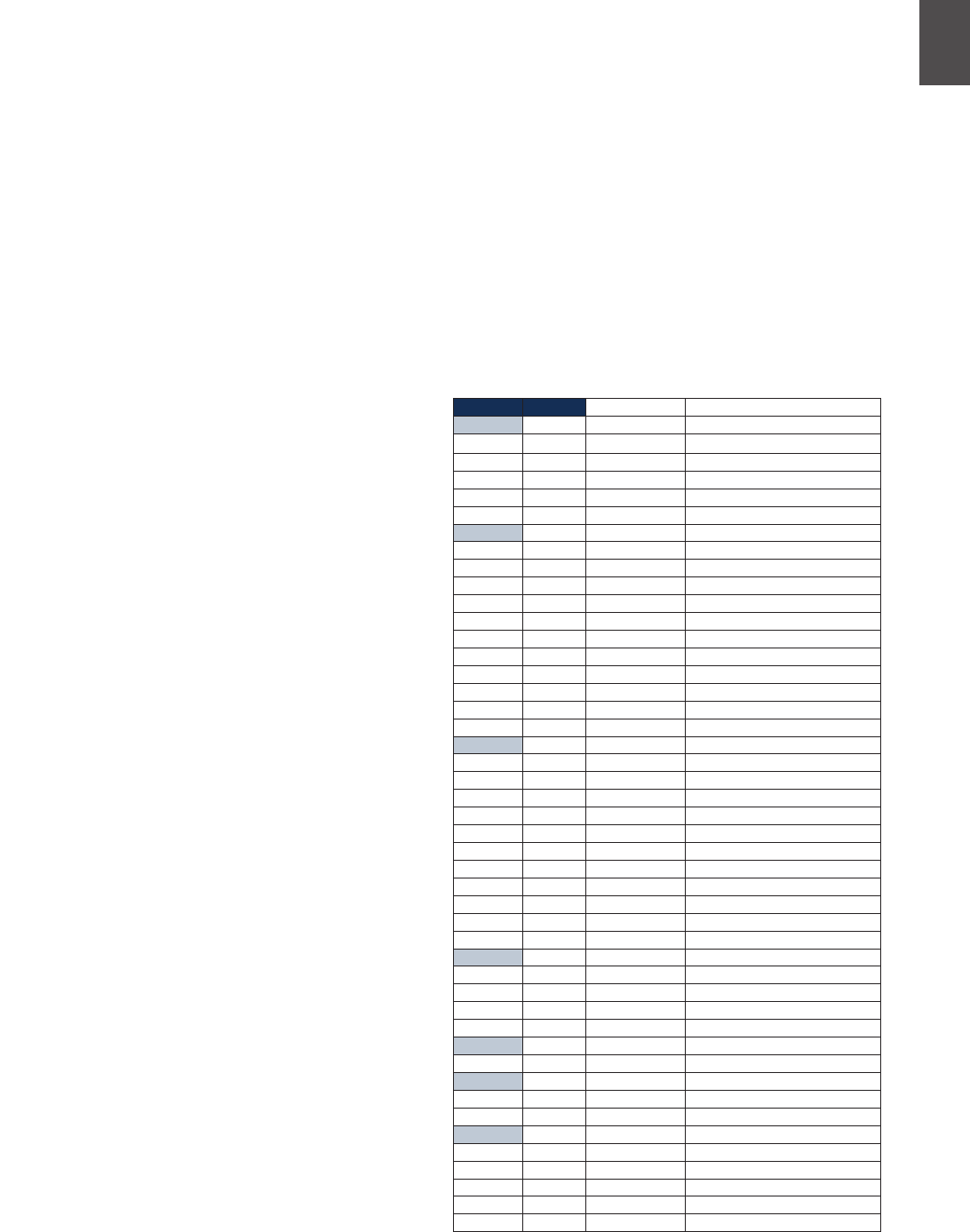
ENGLISH
PRO MIXER DJX700 User Manual
5
engages directly proportionally to the fader’s incremental
movement. When set to logarithmic, the fader’s movement
yields higher volume increases as the fader moves farther
along its range of motion.
XPQ 3D surround eect
The XPQ 3D surround function is a built-in effect that puts the
nishing touch to your music and turns every gig into a real
experience. The widening of the stereo base makes for a livelier,
more transparent sound. You can determine the intensity of the
effect by using the SURROUND control
[27]
, while the XPQ ON
switch
[28]
turns the XPQ effect on (the respective LED is lit).
Auto BPM counter
The integrated auto BPM counter is an extremely useful feature.
It ensures smooth transition from one track to the next, taking
a lot of the guesswork out. It can calculate the various tempos
of tracks in bpm (beats per minute). Both BPM counter sections
are identical and both show the BPM value of the two signals
routed to the crossfader. The LEDs located above the DISPLAYs
1 - 4
[29]
indicate which of the four input channels are routed to
the respective BPM counter.
The tempo of the track assigned by using the ASSIGN A or
ASSIGN B keys is shown in the respective Display
[30]
. Several
tempo changes in one track would produce a constant display
of various BPM values and thus lead to unnecessary confusion.
That’s why the beat counter sections each have a SYNC LOCK
button
[31]
that can be used during the song to limit the range
of possible tempo values. This makes sense if the counter has
already calculated a realistic value. You can do the same thing
manually with the BEAT ASSIST button
[32]
. Pushing this
button at least three times in sync with the song’s tempo results
in the calculated tempo appearing in the DISPLAY. The Beat
Assist and SYNC LOCK buttons are each equipped with a LED.
When you have limited the tempo of the tracks on both channels
with the SYNC LOCK or BEAT ASSIST buttons, the differ-
ence in tempo from both channels is illustrated in the form of
a nine-character message on the TEMPO DIFFERENCE-LED
[24]
. The extent of the difference in tempo is indicated by a
corresponding swing to the right (signal A is slower) or to the
left (signal B is slower). When the middle LED lights up, the
tempi are the same. The TIME OFFSET LED
[23]
below that
displays the signal A and B synchronisation. Should the middle
LED light up, the tracks are synchronised. Should the display
move to the left or right, the channels are not synchronised. The
TEMPO DIFFERENCE and TIME OFFSET displays are only
active if the tempi of both channels have been xed in one of the
ways described.
When no signal is present (or when the signal level is too
◊
low), the BPM display shows only dashes. When the signal
is present but can not be identied, the display shows
160 BPM and then shows the said dashes. The beat counter
then attempts to get another readout. Therefore, “160” BPM
is no usable value; rather, it is simply an error message
when the signal can not be analyzed.
To exit the SYNC LOCK or BEAT ASSIST modes, simply push
the SYNC LOCK button once more on both channels.
Internal eects processor
Presets of the multi-eects processor
GRP EFF
1
0 Reverb Big Plate
1 Reverb Small Chamber
2 Reverb Bright Room
3 Reverb Voice Widener
4 Reverb Phil's Drums
5 Reverb Short Delay
2
0 Delay 1/2 95 BPM
1 Delay 3/4 95 BPM
2 Delay 1/1 95 BPM
3 Delay 1/2 110 BPM
4 Delay 3/4 110 BPM
5 Delay 1/1 110 BPM
6 Delay 1/2 124 BPM
7 Delay 3/4 124 BPM
8 Delay 1/1 124 BPM
9 Delay 1/2 131 BPM
A Delay 3/4 131 BPM
B Delay 1/1 131 BPM
3
0 Echo 1/2 95 BPM
1 Echo 3/4 95 BPM
2 Echo 1/1 95 BPM
3 Echo 1/2 110 BPM
4 Echo 3/4 110 BPM
5 Echo 1/1 110 BPM
6 Echo 1/2 124 BPM
7 Echo 3/4 124 BPM
8 Echo 1/1 124 BPM
9 Echo 1/2 131 BPM
A Echo 3/4 131 BPM
B Echo 1/1 131 BPM
4
0 Flanger Stereo Flanger
1 Flanger Vintage Flanger
2 Flanger Dual Phaser
3 Flanger Rotary Speaker
4 Flanger Stereo Chorus
5
0 Panning Panning
1 Panning Tremolo
6
0 Filter Auto Filter
1 Filter LFO Filter
2 Filter Vinylizer
7
0 Sim/Dyn Ultrabass
1 Sim/Dyn Ultrafex
2 Sim/Dyn Voice Changer
3 Sim/Dyn Tube Amp
4 Sim/Dyn Blues
5 Sim/Dyn Radio Speaker



